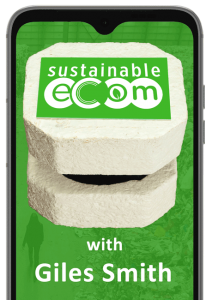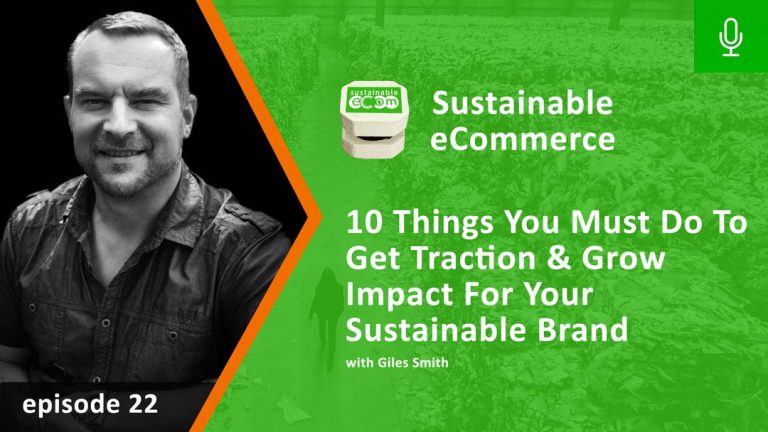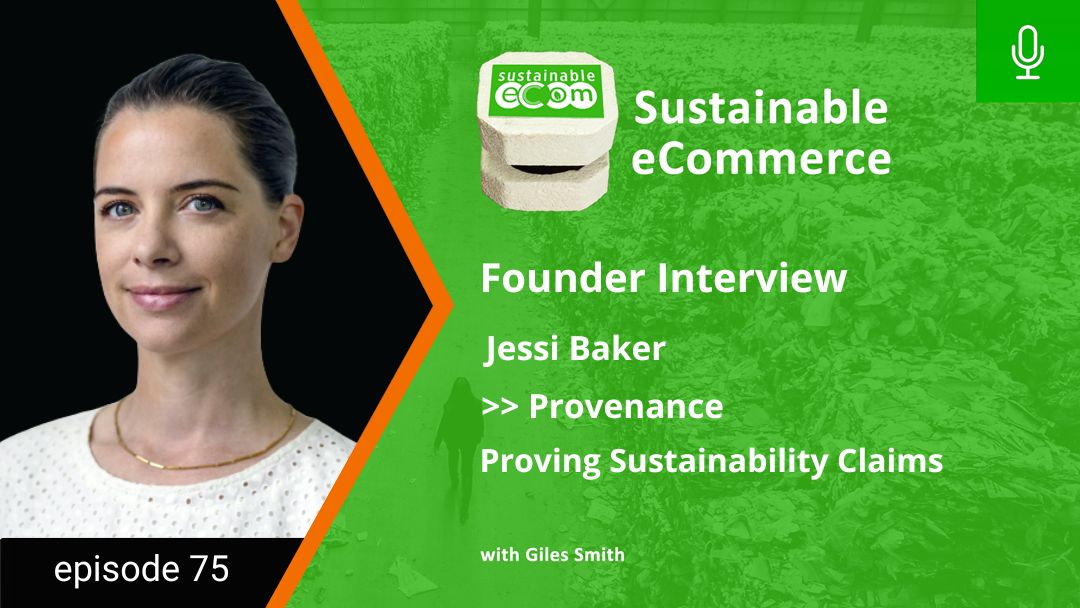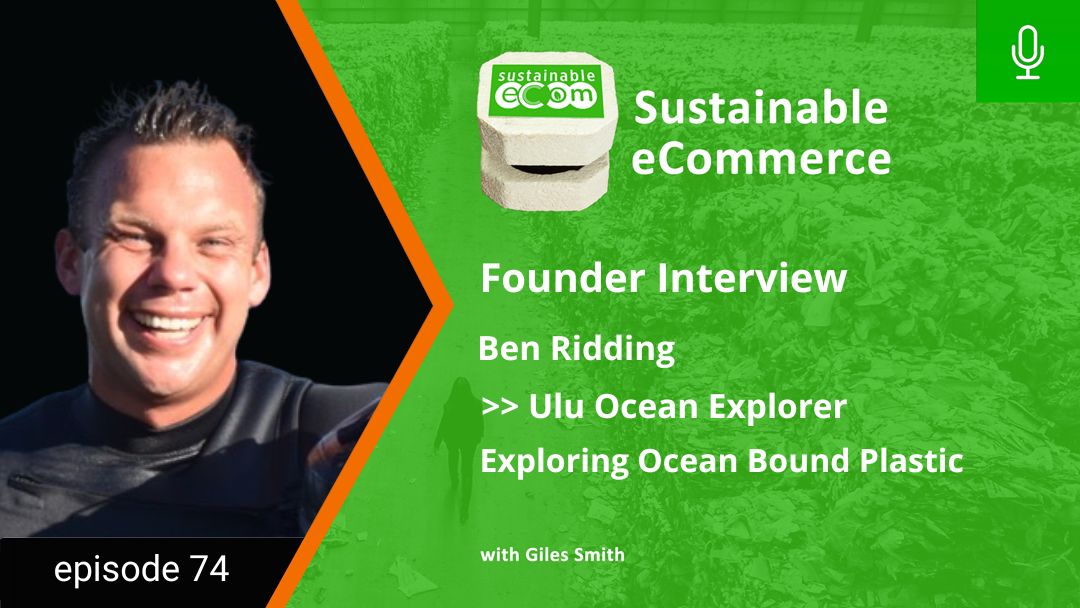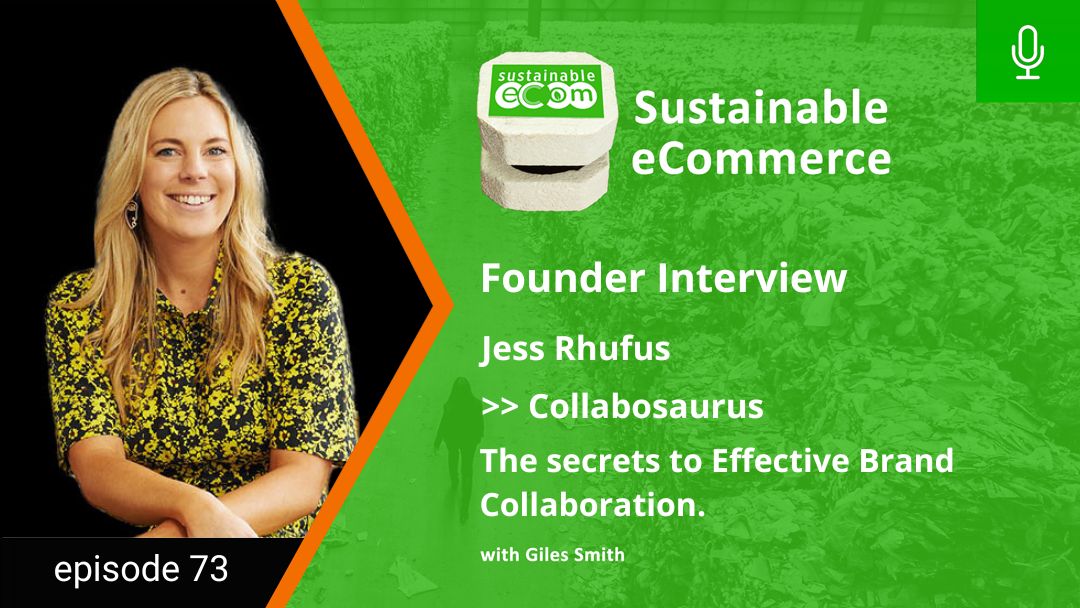Welcome to Episode 22 of the Sustainable Ecommerce Podcast!
I am very excited to kick off this new season today, we have an amazing line up of brand founders & innovators, as well as service providers working to make your brand growth that little bit easier.
Now, over the past few years I’ve been lucky to work with, to interview on the show as well as study and deconstruct the approach of a wide variety of sustainable brands.
As a result, I’ve seen a pattern of strategies and tactics that help deliver success, as well as traps that some founders fall into that really impede their growth.
So today, I’m going to share those insights with you as 10 critical things to get right in order to unlock your growth and ensure your brand has the impact you want it to.
The Big Picture in 2022
Lets first take a look at some interesting research collated in late 2021 by consulting firm Simon Kucher Partners on the degree to which consumers are engaging with sustainability. They studied 10,000 consumers from around the world (including Australia) to learn about their beliefs towards sustainability and to see how those beliefs translate into purchasing habits. Some interesting observations emerge.
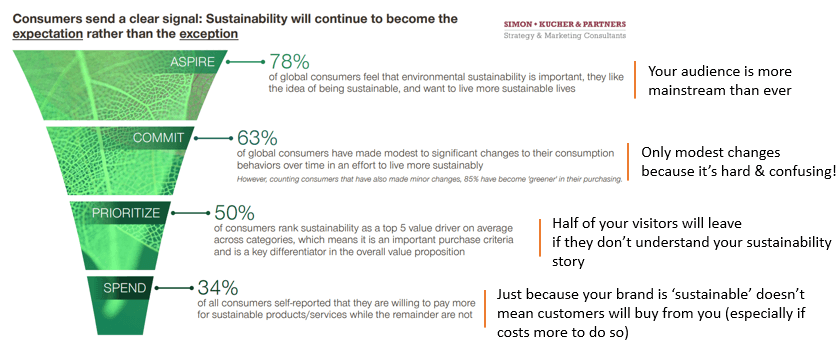
- Nearly 80% of consumers surveyed said they believe sustainability to be important, and they want to live more sustainable lives. That’s massive! If you’re a brand that makes sustainable products, or a purpose-driven brand focused on sustainability, your potential audience is more mainstream than ever!
- 60% of people have made modest changes to their consumption behaviours in an effort to do better for the environment. I think there are two interesting points about this. Firstly, 40% of people have done basically nothing differently! Secondly, why have 60% only made modest changes? We’ll my belief around that is that change is hard. It forces people into a state of pain to break habits, and generally people try to avoid change, even when they know its good for them. In addition, environmental issues are immensely confusing, and often seem like an existential problem that they have no impact on. In other words, they don’t know what to do.
- Next, 50% of consumers see a products sustainability profile as being a top value driver when it comes to making purchasing decisions. Its seen as a key differentiator, but only if they can clearly identify it. That means that having done all the hard work to get the right people to your store, half of them will leave if they can’t understand how your product is sustainable, so presenting information in a clear, transparent and very visible way is critical.
- And finally, when it comes to the point of purchase, only about 30% of consumers responded that they are willing to pay more for sustainable products. With the cost-of-living crisis in full swing, that means that just because your brand is sustainable, doesn’t mean people will buy from you. I do think there’s devil in the detail on this one that the report didn’t explore, specifically around crafting stronger messaging, so I’m going to come back to that later.
So that research report gives us some useful context as we run towards the end of 2022. Sustainability is now a mainstream desire for consumers. While most want to do better, few have made changes so far, leaving the market truly open for the brands that help them make that transition easy. That’s a huge opportunity for your brand, but it also means we’ll likely see a huge increase in competition over the next few years. So what can you do in your brand to set it up for success, capture the market and allow you to make impact you’ve always dreams of?
Well, let’s get started with today’s 10 tips.
1: Actually Balance Profit & Purpose
For generations, since time began it seems, people have made money by reaping our natural resources, not being mindful of their mostly negative impact on the planet and on the many lives of the people in their supply chain. In other words, you got rich by doing bad, and it was down to not-for-profits & governments to somehow fix that all up. Needless to say, that hasn’t worked.
As a result, I think there is still a lot of stigma among sustainable and ethical brands around making profit. Like somehow being profitable detracts from their mission. I’ve seen this many times in founder-led brands who struggle to survive on wafer thin margins because they want to be seen as doing good. It’s often demonstrated through a fear of increasing their prices, even when they already have low or highly competitive pricing.
Taking an aside into pricing for a moment, we just heard from the report that only 30% of consumers are willing to pay more for sustainable products. If that is the case, then that still 30% of basically everyone, so that’s still a heck of a lot of potential customers that are willing to pay more.
But more importantly, price sensitivity is typically one of the main features of a commoditised market, and I would argue that the market for sustainable products is not even close to being mature enough to be called commoditized.
This isn’t the only research report I’ve seen this in, and I’m hearing it from brands in the market place, so why the disparity? As we’ll discuss shortly, that absolutely comes down to your messaging and how you’re telling and selling your story throughout the customer journey.
But back onto the topic of balancing profit & purpose, it's time for a new way of thinking – and to that end I think the BCorp philosophy is exactly right here. How great would it be if in the future, the most successful entrepreneurs, the ones appearing in the Forbes list are the ones making the most profit AND having a positive impact on the world?
Profit is not a dirty word. It enables your brand to have impact. Without profit you can’t sustain your brand. You can’t invest in marketing to reach more people, you can’t invest in new products to serve your customers, you can’t attract and keep the best talent. More profit can also mean more impact. Just look at Who Gives a Crap – they give 50% of their profits to charities that support their cause. They chose NOT to go into many retail chains early on because it was less profitable to do so. Had they not focused on profit, they would not have been able to donate $10M to bringing sanitation and water equality to many of the world’s poorest areas.
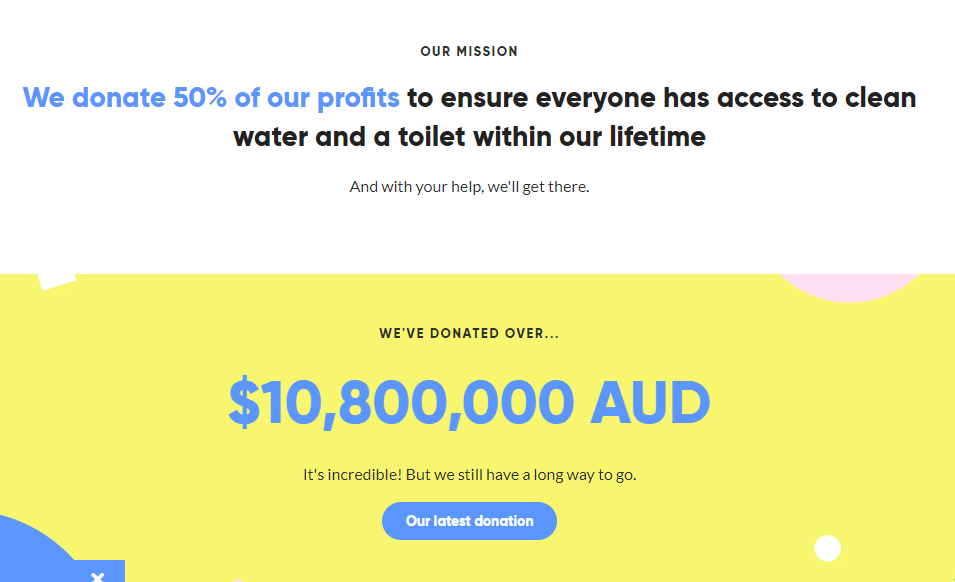
Another really important point here is that, if you’re a purpose-driven brand, sooner or later you’re going to need to invest in certifications and prove the claims you’re making in regard to your mission. B Corp that I mentioned earlier was just one. That in itself isn’t that expensive, but you’ll often need to go ahead an get impact audits on your supply chain, carbon assessments and other independent evaluations, all of which can cost many thousands of dollars both initially and annually. Without profit, you simply can’t cover that.
Unfortunately it isn’t a level playing field, and proving you’re doing what you say is really one of the key ways consumers can distinguish your brand from one that relies on greenwashing to capture the same market.
2. Build Purpose Into Your Business Model
Now I mentioned Who Gives a Crap a moment ago. They are a great example of the classic model for business doing good, in that they take a portion of their profit at the end of the year and donate some of that to causes that matter to them. For established businesses that often sits on their Balance sheet through the year as a liability, getting cleaned up at reporting time. For small, founder led business though, the conversation often shows that the donations to their cause are more or a mental note-to-self, with the intention to give up some of their profits at the end of the year. The problem with that for start-ups is that, especially in eCommerce, it can take several years to turn a profit, and many run for years almost as pet project of the founders, without having the impact they hoped for.
Moreover, consumers are becoming more cynical of profit-related allocations, often linking them to value-signalling ESG & CSR initiatives rather than a real commitment to doing good.
It's time to rethink that model.
There’s a new generation of purpose-led business coming through who’s activities directly contribute to the impact they want to have.
Take Zero Co here in Australia, who’s mission is to solve the plastic pollution problem by removing single use plastic from the laundry, kitchen and bathroom. Customers purchase starter packs of various spray bottles and containers that they call ‘forever bottles’, and then purchase refillable pouches that they send back to Zero Co when empty in a completely closed-loop re-useable model. Their forever bottles are made from reclaimed Ocean Plastic, and purchasing the starter packs helps them fund ocean clean-ups. Every pouch refill is another bottle that doesn’t end up in landfill.
ZeroCo may choose to donate additional funds from profits at the end of the year, or they may simply fund more ocean cleanups directly, either way their impact is baked directly into their business model.
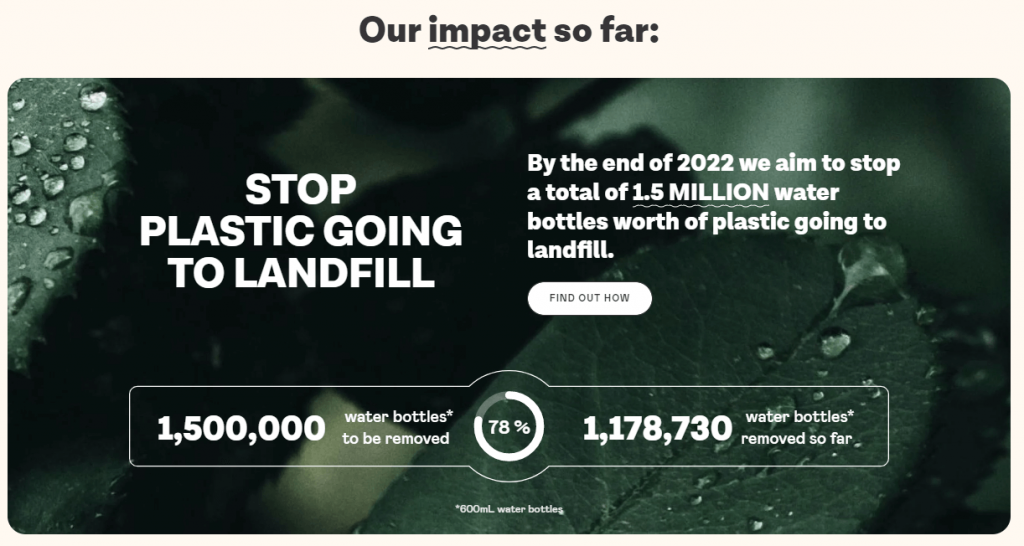
Want to know more about Zero Co? Check out Episode 9.
We can’t all run businesses like Zero Co, where the products themselves are the impact they want to see. But there are other creative ways to build impact directly into your business model. Once of my coaching clients for example, make personal organiser products using FCS Certified recycled paper, coffee cups and other sustainable materials. That’s awesome in itself, but her mission is to replant the planet & undo the harm done to our native forests by the paper industry. Accordingly, we’ve priced into her model to plant trees with every order, and she encourages repeat purchasing by committing to protect an extra 2m2 of native rainforest every third order.
So you don’t need to wait until the end of your financial year to make donations. Incorporating your impact directly into your business model, and including into your P&L is a great way to ensure your brand is making a difference right from day one.
3. Market to the audience that exists now (not 5 years ago).
A mistake I see so many brands making, especially if they’ve been around for a few years and were operating pre-pandemic is in thinking their potential customer base is still dominantly eco-warriors. 5 year ago, maybe even 3 years ago, certainly here in Australia, it was largely the strongly eco-minded consumers who were desperately seeking environmentally friendly products and sustainable brands to buy them from. Sustainable solutions were hard to find, so as long as you could show them why your product matched their values, they would snap it up.
Fast forward to 2022/2023, that’s not the case any more. As we saw from the research report, 80% of consumers want to live more sustainably, 60% are actively making changes to what they purchase, and half consider sustainability to be an important factor when choosing what to buy. That means quite simply, sustainability-based purchasing is mainstream. In fact, as market dynamics go, I believe we’re now in the early majority phase, that means that over the next few years, we’re going to see the fastest growth in uptake from consumers as well as the fastest growth in competition to meet that demand.
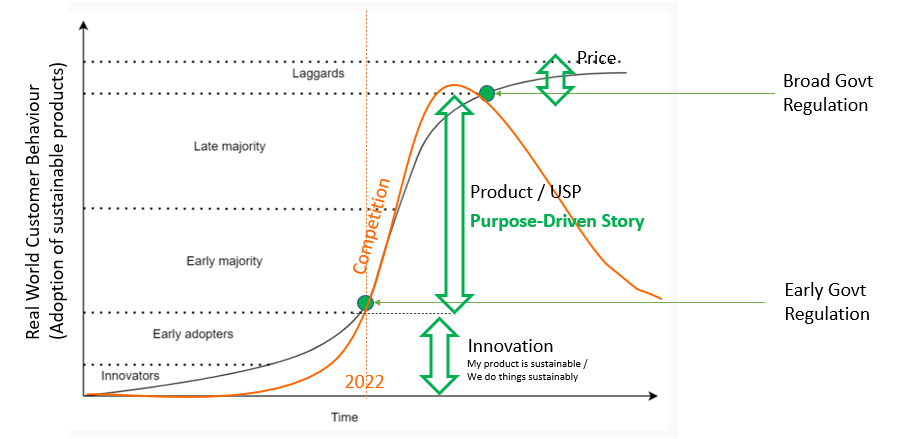
While you may have had success in the past attracting eco-warriors, and they no doubt continue to be valuable customers, unlocking growth for your brand going forward is going to be about resonating with mainstream consumers.
That means a different messaging approach, because mainstream consumers balance product benefits & sustainability benefits in a different way to eco-warriors.
Eco warriors will buy sustainable products because they’re in line with their beliefs and they fit into and help them support the way they want to live their lives.
Mainstream customers want to solve their problems with great products first, and the sustainability of that product or service is either a must have or nice to have as a secondary consideration.
Growing your brand going forward is also going to be about communicating what you do in a way that cuts through the increasing noise from sustainable competitors flooding in, as well as slower moving brands value signalling and just plain greenwashing.
4. Design Products to give a better experience than their non-sustainable alternatives.
For almost any brand, a great approach for product development is to get a version 1 product to market and then rapidly improve it so it solves your customers problems more effectively than existing alternatives. Having a ‘good enough’ sustainable product in the market is almost always better than a ‘perfect’ product that never gets launched. Where I see a surprisingly large number of sustainable brands falling short, and this is particularly true for brands that have been around a while, is when they assume that simply using sustainable or recycled materials makes it a better product.
Remember that mainstream consumers are not the same as eco-warriors. Eco Warriors might be prepared to put up with some performance trade-offs in exchange for sustainability benefits, but by and large, mainstream consumers want to solve their problems first. Yes, they might consider sustainability an important factor when making their purchasing choices, but if your products are just OK, customers will pretty quickly revert back to what they know because you’re not solving their problems more effectively.
Worse still, they won’t always go quietly. In most cases, using sustainable materials means that our Cost of Goods is higher than a non-sustainable alternative, which of course means that our price point is likely higher as well. Remember, from the survey only 30% of customers noted they were willing to pay more for a sustainable alternative. Mainstream customers get particularly moody when they’re asked to pay more and the product isn’t even as ‘good’ as what they’re used to using. If your products are more expensive and seen as ‘not as good’, even if they are better for the environment, you’ll end up with refunds, returns, bad reviews and ultimately a loss of traction.
Of course, better is a subjective term that doesn’t necessarily just relate to the perceived or actual quality of the product. Ultimately, “better” is a judgement of the total customer experience, and that becomes especially relevant when discussing brands that operate a circular or re-use model.
Many experts believe that circularity is the only truly sustainable model, and for what it’s worth I’m behind that as well. But circularity is not without its customer experience issues.
Our whole lives as consumers have been optimized for linear consumption. Buy – use – throw away. Although circularity is excitingly being adopted in a number of industries including apparel, its actually consumable products that are really shining so far in this space.
By consumable I mean anything that is shipped to you in primary packaging – a container of some sort, like a tin, bag, case, tube, dispenser. You use what was inside the container, and then you’re left with just the empty container. That could be anything from a bag of dog food, to coffee pods, printer cartridges, home cleaning, personal care products and just about anything that needs to be contained, held together or protected in primary packaging.
That’s useful because the container typically creates waste in the linear model and it costs money to produce, so there’s value in re-use.
Want to learn more about building a circular brand? Check out Episode 20 with Jamie Forsyth from Returnr
So the central challenge then for anyone building a circular business model is to design into your system an easy, frictionless way of reclaiming that container, and splitting the reclaimed value with your customer.
And herein lies the rub for making a better product. Remember I said that ‘better’ applies to the overall experience of buying and using your product.
While eco-warriors may be happy to interrupt their day, and bring things back in person mainstream consumers may not be so forgiving and of course physical presence return is a tough thing to scale geographically. To keep mainstream customers in your loop, their return experience needs to be as frictionless as possible so it doesn’t become a reason to slip back into all-too-easy buy-use-throw away model.
Obviously, the easiest possible thing for the customer is to collect the item direct from the customer’s front door, and for that reason I think we’ll see an explosion in demand of reverse logistics in the next few years. Failing that, giving them a free shipping label for good old Aussie Post is a tried and tested way for eCom brands to handle returns, and most shoppers are used to it.
Whatever you do, don’t ask the customer to pay for return shipping – that is NOT going to give a seamless experience, or even one on par experience with your linear competitors.
5. Use Packaging to Tell Your Story
As sustainable brands I think we tend to have a hate-hate relationship with packaging, and really for good reason. It’s one of the Achilles heels for eCommerce given that we do have to deliver the product in good condition, yet packaging accounts for an eye watering percentage of landfill. Consumers hate having to deal with it. As a result there’s been a trend for some time for brands to focus on eliminating packaging as part of their story.
I think that’s noble and its good – you should definitely try and eliminate unnecessary packaging and choose the many sources of sustainable packaging over plastic, and if you need help with that, I’ve got my friends at Heaps Good Packaging coming on the show in a few weeks.

But it’s entirely possible to go too far. I’ve seen some brands end up with increased returns due to damaged goods, which is obviously counter-productive.
Instead of elimination at all costs, rather rethink your packaging to minimise it and then leverage what you do need for maximum value.
Your packaging can actually a very powerful marketing and storytelling tool. If you’re wholesaling your products, think about how you can stand out as a sustainable alternative on the shelves.
Simple things like green & brown earthy tones on the packaging send signals to the buyers.
Think about how you can tell your re-use story. As consumers we’re not used to reuse, and the real estate you have on your packaging, both display and shipment packaging can be a useful tool in educating and reminding customers what your brand is about and what they need to do with your product once it’s used up.
Speaking of story, that leads me to my next few points in relation to messaging.
6. Take a back seat and let your customer shine.
There’s a really interesting polarisation that’s been happening among sustainable brands over the past 3-5 years. Some founders openly talk about the great work their brand is doing, strongly leveraging their impact to stand out in the crowd. That does make complete sense to me, I mean we’ve typically sweat blood and tears to get our brands to market and we’re rightly proud of them and what we’ve built.
Then there’s the other camp where the environmental benefits of using or buying their products, or the impact they’re having through other philanthropic work is kind of buried behind fears of accidental greenwashing or being called out for using their initiatives as a marketing ploy. Instead they focus on their products or service benefits, relying on their USP (if they truly have one) to capture interest.
Like I mentioned earlier, bringing your impact initiatives into your actual business model is one way to head those kind of considerations off at the pass, but the reality is that both of these messaging approached miss the mark. There’s something they are missing which in my view is absolutely critical to successful marketing as a sustainable brand.
In working with, interviewing and studying a huge variety of sustainable brands, I’ve been looking for commonalities in what they’re doing with their marketing to enable success.
One thing that kept coming up in messaging is the notion of making the customer the hero. Now I’ve been using the Storybrand framework by Donald Miller for years and highly rate it as a framework for brand messaging.
In Storybrand, you recognise that like any good story, the hero is the main character (your customer), and the hero needs a guide (you). It recognises that the customer wants to solve their problems and be the hero in their own life, and doesn’t need your brand muscling in trying to take the spotlight.
So, I initially latched onto that idea, but quickly realised that that didn’t quite fit. In fact, what many of the really successful brands are doing is showing how the customer is actually the hero in the brands mission. After all, they are the ones who’s purchases make it all possible.
They key here is that right now, is that mainstream customers actually have 2 problems. The first is whatever need is driving them to purchase your product in the first place, but the second is this unsolved disparity between wanting to do better for the environment and actually being able to make impactful changes.
When you make people the hero in their own life, that’s one step up from selling features & benefits, but when you cast them as the hero in a mission that’s good for the planet – that’s a whole new level.
So, take a close look at your messaging. Is it shouting about how great your brand is, or the opposite, burying all the good work you’re doing and focusing on product USP? If so, look at turning it on its head and instead focus on how you can position the customer as the hero in your mission.
7. Show how using and/or buying your products makes it easy for the customer to be the hero
Sustainability is immensely confusing, even to those of us working in the space. Eco Warriors are often clued up about the benefits one material over another, but even they can get bamboozled by supply chain transparency and what your overall achievements towards Carbon Neutrality vs Net Zero really means.
The potential to confuse is even more problematic when marketing to mainstream customers, who you’ll recall primarily want to solve their problems. Whatever way you cut it, confusion is the opposite of clear, powerful messaging and will without doubt lead to lost sales.
As we saw earlier even though 80% of people want to do better for the environment, 40% of people haven’t made any changes to their purchasing habits and most of the remaining 60% have only made small changes. That’s simply because change is hard. It can be seen as scary and there is almost always some degree of discomfort involved, which for most mainstream customers is something to be avoided.
So it’s vitally important that you show the customer how easy you make it to make a sustainable choice. Remember, the customer is the hero, and you are their guide. You have to do the hard work to help the customer achieve their goal.
One very powerful way to do that is to take a fresh look at how you communicate you’re brand’s impact. For example, as well as promoting that your business overall has saved 1 million plastic bottles from ending up in landfill, let the customer know that the item they are about to purchase directly saves 2 more bottles from landfill.
Suddenly, they clearly understand their impact, and they can see how purchasing from you is making it easy for them to have an impact.
By breaking the impact down to the item being purchased, the impact of an overall order, and a customer’s combined impact over all of their orders with you, you’ve turned a hard to grasp and somewhat ethereal concept into something very tangible.
All the customer needs to do is purchase from you, and they’ll have an impact. Easy Peasy!
Let me give you two examples here:
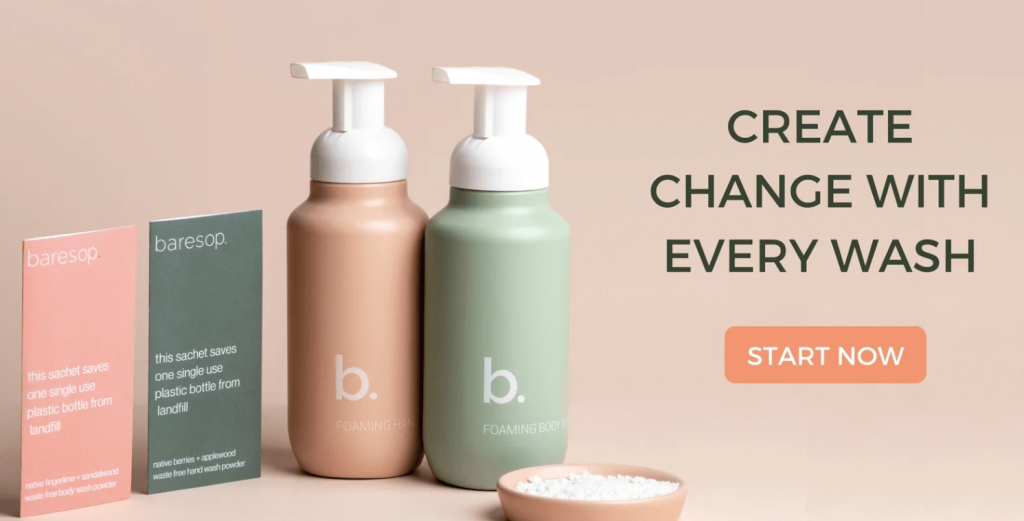
Baresop is Australian startup making powdered hand soap. A bit like Zero Co earlier, their mission is to shake up the personal care industry and remove single use plastics. You purchase a dispenser bottle, and buy or subscribe to powder-base soap refill sachets. Each home compostable sachet replaces a single use plastic bottle, and their pre-and post -purchase marketing very strongly communicates that that’s what’s happening. In other words, every purchase has a direct and clear impact.
Boody is perhaps a better known Australian brand, recently having branded themselves as the official underwear of the entire planet. The short story is their apparel is made from bamboo not cotton. They make the impact transparent for each item with things like a measurement of the driving emissions saved, light bulb hours of energy saved, litres of water saved etc, all compared to an equivalent cotton item. Once again, you’re very clear exactly what impact your purchase will have, making it easy to be the hero.
When you add this granular level of impact into your messaging, you’re not only showing how you solve product-related problem, but now you’re solving their internal tension at wanting to do better for the environment, but not knowing quite how.

Incidentally, Boody’s item-level impact messaging is driven by Greenstory, a sustainability assessment and store plugin system, and I’ll be releasing an interview with their founder & CEO Akhil Sivananden later in the series. I raise that because one of the things I particularly like about Greenstory is how it allows you to present your sustainability data in relatable metrics. For example, instead of ‘1.5 tonnes of CO2 saved’, Boody describes it as ‘2.1 KM of driving emissions’. The language you use is just as important as the facts you’re presenting, which brings me onto my next point.
8. Use Positive, Action Orientated, and simple to understand language.
Leave the customer feeling good as a result of their interaction with you, whether they buy or not.
I’ve seen so many brands start their interactions with frightening statistics about pollution and climate change in the hope of making scroll-stopping content. I guess the philosophy is “if we alarm people by how bad things are, we can motivate them to buy our do-good things”. I’m sure you’ve all seen messaging like this. Well, let me tell you, if you make people feel bad, they’ll just leave.
That kind of guilt-trip marketing can lead to having you FB account shut down. I spoke to one prospect customer not a long ago who mentioned that’s exactly what happened and she complained that Facebook were protecting the big plastic manufacturers. The reality is though her messaging was basically making people feel bad about using plastic, and that’s not aligned with the experience Facebook wants for its users.
We all have enough doom & gloom in our lives, we don’t need to get beaten with it when we’ve just met a new brand. Instead, use positive language that calls your customer to action and gives them a clear pathway to making changes and becoming the hero.
Like we’ve already discussed, sustainability is confusing. Don’t confuse the customer with complicated language, jargon or difficult to grapple metrics. But at the same time don’t be patronising or talk to the customer like they’re idiots. In fact, they’re the heroes, so you want to treat them like key stakeholders in your mission, and keep them close with regular updates on your progress, which leads me to the next important consideration:
9. Regularly share mission updates on your journey
Your story isn’t just your mission and goals, and its certainly not just about what you’re selling. It’s the journey towards those goals that becomes compelling, like any great saga, the twists and turns along the way that serve to keep the audience captivated. Regularly sharing your progress, both good and bad is part of what we call Active Transparency.
But giving updates for your mission isn’t just fluffy stuff though, there are some real objectives here. You want to remind the customers and the community who the hero is (ie them) and show them the impact they are having collectively. You want to show momentum – make the audience feel like their action in choosing you means something and that they are in safe hands.
I covered how to use Active Transparency in more detail in the last episode, so check that out fore more detail on how to convey you news messages, but for now I want to cover off the last point from this list of 10 must-dos:
10. Leverage education as an ongoing source of value for your customer.
Learning to do better for the environment is not a once in and done type of action. It’s a journey, full of twists & turns. Sustainability science is evolving all the time too, which presents us with an opportunity to educate the customer and become a source of ongoing value in their life, beyond the simple transactional relationship.
This is a natural extension of the model where the customer is the hero, and your brand is their guide.
A common mistake though, is in how that educational content is delivered. Oftentimes it can feel like you’re pumping out content and no-body is listening.
Remember that you’re asking people to make changes in their life, to do things differently. For customers to do that means they need to trust and relate to their guide.
They need a real person to share their journey with, not a faceless brand. Training material falls flat when there isn’t a person behind the delivery. For that content to be of value to your brand as well as the customer, it means that, if you’re the founder of the brand, it’s your job to be their guide. You can’t hire someone else to do it, and you can’t delegate it. People want to relate to and see you as the visible face of the brand.
If you’re a founder-led brand, this very fact gives you an interesting competitive advantage over bigger brands.
If you learn to do this well, your educational content can become an incredible way to attract and engage your audience, and of course you get the opportunity to tell your story at every turn.
So there we have it, 10 big suggestions to consider in your brand in order to drive the growth and the impact you know you should be creating. The main themes today, don’t lose sight of profit in your drive for purpose. Build impact directly into your business model rather than as a donation from profit at the end of the year. Tell your story proudly, but do it by casting the customer as the hero in your mission. Doing that will allow you to clearly communicate to the mass mainstream of consumers, charge higher prices and cut through the noise of new competition. And invite your customers on the journey with active transparency and education.
I hope you’ve enjoyed today’s episode, we’ll be back next week with another awesome founder interview, but until then, keep building your brand for a healthier planet!





